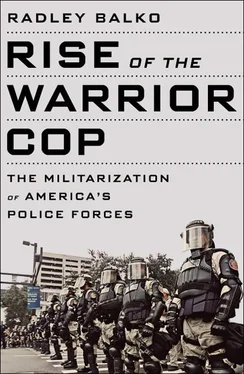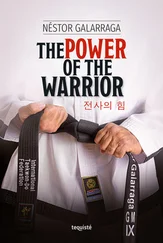57. The McWilliams narrative is from R. W. Bradford, “The Life and Death of Peter McWilliams,” Liberty (August 2000); “Los Angeles Drug Case Bars Medical Marijuana Defense,” New York Times, November 7, 1999.
58. Paul Richmond, “True Stories from the Front Line,” PDXS, October 22, 1995.
59. Kraska and Kappeler, “Militarizing American Police,” p. 13.
60. Steven Elbow, “Military Muscle Comes to Mayberry; U.S. Donates Gear, Grenade Launchers,” Madison Capital Times, August 18, 2001.
61. John L. Worrall and Tomislav V. Kovandzic, “Cops Grants and Crime Revisited,” Criminology 45 (1, February 2007).
62. The McNamara narrative is taken from Julie Lew, “What’s Doing in San Jose?” New York Times, April 7, 1991; Peggy Y. Lee, “Violent Crime Up; Homicide Looms,” Los Angeles Times, August 8, 1991; Kathleen O’Toole, “Panelists Play Themselves in Fictitious Drug Raid,” Stanford Report, November 12, 1997; Joseph McNamara, “Changing Police Attitudes in the War on Drugs,” paper presented at the 37th International Congress on Alcohol and Drug Dependence, August 1995; various materials from the conference “Pragmatic Solutions to Urban Drug Problems,” Hoover Institution, November 6–7, 1997; and Joseph McNamara, interview with the author, August 2012.
63. The North Hollywood narrative is from Rick Orlov, “North Hollywood Shootout, 15 Years Later,” LA Daily News, February 27, 2012; 44 Minutes: The North Hollywood Shoot-Out, directed by Yves Simoneau (2003); Peter Prengaman, “10th Anniversary of Infamous LA Shootout That Changed Policing,” Associated Press, February 28, 2007.
64. The Columbine narrative is from David Kopel, “Police Stood Idle,” New York Post, April 20, 2000; Bovard, “Flash. Bang. You’re Dead”; “What Really Happened at Columbine?” CBS News, 60 Minutes, April 29, 2009.
65. J. R. Clairborne, “Members Start Training, Learn New Jobs, Cross Train,” Ithaca Journal, March 15, 2000.
66. Scott Andron, “SWAT: Coming to a Town Near You? Academics Decry ‘Military’ Mind-set,” Miami Herald, May 20, 2002.
67. Seth Koenig, “Portland Police Get New Military Grade Armored Vehicle,” Bangor Daily News, June 7, 2012.
68. Leslie A. Maxwell, “School Shootings in Policy Spotlight,” Education Week, October 11, 2006.
69. Lauren Dunn, “UNC Charlotte SWAT Team—An Asset We Hope to Never Use,” NinerOnline, October 23, 2011.
70. Norm Stamper, interview with the author, August 2012.
71. Kopel and Blackman, No More Wacos; Kraska and Kappeler, “Militarizing American Police”; 2001 estimate from author interview with Kraska, March 2006; Kraska and Kappeler, “Militarizing American Police”; 2001 estimate from author interview with Kraska, March 2006; Edward Ericson Jr., “Commando Cops,” Orlando Weekly, May 7, 1998; Richmond, “True Stories from the Front Line”; Kraska and Cubellis, “Militarizing Mayberry and Beyond.”
Chapter 8: The 2000s—A Whole New War
1. Betty Taylor, interview with the author, September 2012.
2. William Rhodes, Christina Dyous, Meg Chapman, Michael Shively, Dana Hunt, Kristen Wheeler, “Evaluation of the Multijurisdictional Task Forces (MJTFs), Phase II: MJTF Performance Monitoring Guide, National Institute for Justice, February 2009.
3. For a thorough, well-reported account of the Tulia scandal, see Nate Blakeslee, Tulia: Race, Cocaine, and Corruption in a Small Texas Town (New York: Public Affairs, 2006).
4. The Hearne narrative is from the author’s interviews with Regina Kelly and ACLU personnel who handled her case; Jay Jorden, “Seventeen Drug Cases Dismissed,” Associated Press, April 4, 2001; American Civil Liberties Union, “In Wake of ACLU Civil Rights Lawsuit Settlement, African Americans Affected by Texas Drug Task Force Scandal Call for Reconciliation at Town Meeting” (press release), June 2, 2005; Nathan Levy, “Bringing Justice to Hearne,” Texas Observer, April 29, 2005.
5. “As the Well Runs Dry, Texas Drug Task Forces Ride Off into the Sunset,” Drug War Chronicle, April 7, 2006.
6. Radley Balko, “Wrong Priorities,” FoxNews.com, April 7, 2008.
7. US Department of Justice, “Overview of the American Recovery and Reinvestment Act of 2009,” available at: http://www.ojp.usdoj.gov/recovery.
8. The Sepulveda narrative is from Rebecca Trounson, “Deaths Raise Questions About SWAT Teams,” Los Angeles Times, November 1, 2000; Ty Phillips and Michael G. Mooney, “How Did the Gun Go Off? Police Report Fails to Answer Question in SWAT Shooting of Alberto Sepulveda,” Modesto Bee, January 11, 2001; Michael G. Mooney, “Boy’s Death Costs Modesto $2.55M,” Modesto Bee, June 20, 2002; Rebecca Trounson, “Suit Could Put Limit on Use of SWAT Teams,” Los Angeles Times, January 16, 2001; and California Attorney General’s Commission on Special Weapons and Tactics (SWAT), “Final Report,” September 10, 2002.
9. The drug war–terrorism narrative is culled from Radley Balko, “The Drug War: Throwing Good Money at a Bad Idea,” FoxNews.com, February 28, 2002; “Thailand’s Drug War: Back on the Offensive,” The Economist, January 24, 2008; Ted Galen Carpenter, “How Washington Funded the Taliban,” Cato Institute, August 2, 2002; Dan Kovalik, “The US War for Drugs and of Terror in Columbia,” Huffington Post, February 16, 2012.
10. See Heidi Lypps, “Bush’s Crackdown on Medical Marijuana,” Counterpunch, September 17, 2002.
11. Mitch Albom, “A Serious Look at Wacky Weed and Suffering,” Detroit Free Press, September 22, 2002.
12. Louise Witt, “Bush’s Reefer Madness,” Salon, November 5, 2002.
13. Quoted in Lypps, “Bush’s Crackdown on Medical Marijuana.”
14. See Ronald T. Libby, “Treating Doctors as Drug Dealers: The DEA’s War on Prescription Painkillers,” Cato Policy Analysis 545 (Washington, DC: Cato Institute, June 6, 2005).
15. For examples of such raids, see Frank Owen, “The DEA’s War on Pain Doctors,” Village Voice, November 5–11, 2003; and Eric Fleischauer, “Physicians Casualties in the War on Drugs,” Decatur Daily News, October 27, 2003.
16. Keene-DHS narrative from author interviews and reporting and Andrew Becker and G.W. Schulz, “Local Police Stockpile High-Tech, Combat-Ready Gear,” Center for Investigative Reporting, December 21, 2011.
17. Rob Golub, “City, Police Go on Trial for Response at 2002 Rave Party,” Racine Journal Times, January 10, 2005; “Stories from the Racine ‘Rave Raid,’” ACLU, January 17, 2003.
18. Glenn Reynolds, “Raving Lunacy,” FoxNews.com, July 25, 2002; Will Doig, “Chemical Warfare: The RAVE Act,” MetroWeekly, October 7, 2002.
19. Rashae Ophus Johnson, “Witnesses Say Undue Force Used at Rave,” Daily Herald, August 23, 2005; Michael N. Westley, “Police Raid Rave Party in Spanish Fork Canyon,” Salt Lake Tribune, December 14, 2005.
20. “Drug Raid at SC High School,” CBSNews.com, November 7, 2003; “Principal at Drug Raid School Resigns,” CNN.com, January 5, 2004; Tony Bartelme, “Raid Settlement Gets Initial OK,” Charleston Post and Courier, April 5, 2006.
21. “Profile of Le’Quan Simpson,” ACLU, December 15, 2003.
22. John Stevenson, “All Cheek Road Drug Raid Charges Dropped,” Durham Herald-Sun, July 13, 2002.
23. Maki Becker, “How Effective Is the Drug War?” Buffalo News, May 24, 2006; Vanessa Thomas and T. J. Pignataro, “Three Days of Secret Police Drug Raids Bring 78 Arrests Throughout City,” Buffalo News, April 21, 2006; “Giambra Suggests Discussion on Legalizing Drugs,” WBEN News, April 19, 2006.
Читать дальше












